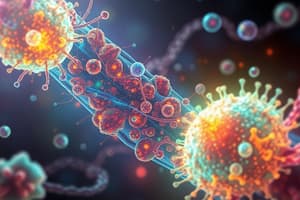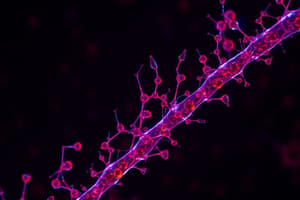Podcast
Questions and Answers
Which statement best describes natural selection?
Which statement best describes natural selection?
- The process that leads solely to the creation of new species.
- The random change in gene frequencies within a population regardless of adaptation.
- The mechanism where better-adapted organisms have a higher chance of survival and reproduction. (correct)
- The process by which all organisms evolve at the same rate.
What is the main focus of the study of physiology?
What is the main focus of the study of physiology?
- Investigating the functions of living organisms. (correct)
- Analyzing the genetic composition of different species.
- Classifying life forms based on evolutionary relationships.
- Examining the anatomical structures of organisms.
Which of the following illustrates a physiological process?
Which of the following illustrates a physiological process?
- The process of nutrient absorption in the digestive tract. (correct)
- The arrangement of bones in a vertebrate skeleton.
- The pattern on a butterfly's wings.
- The classification of a plant within a taxonomic hierarchy.
What does the term 'binomial nomenclature' refer to?
What does the term 'binomial nomenclature' refer to?
How does the Linnaean system classify organisms?
How does the Linnaean system classify organisms?
Which of these best describes the roles of RNA?
Which of these best describes the roles of RNA?
Which of the following is NOT a characteristic of prokaryotic cells?
Which of the following is NOT a characteristic of prokaryotic cells?
Which biological discipline primarily focuses on the study of heredity and variation of inherited traits?
Which biological discipline primarily focuses on the study of heredity and variation of inherited traits?
What is the central dogma of biology?
What is the central dogma of biology?
What is the study of interactions between organisms and their environment called?
What is the study of interactions between organisms and their environment called?
Which of the following best describes the role of DNA?
Which of the following best describes the role of DNA?
What are the fundamental units of life?
What are the fundamental units of life?
Which discipline studies the change in heritable characteristics in populations over generations?
Which discipline studies the change in heritable characteristics in populations over generations?
Flashcards
Natural Selection
Natural Selection
The process where organisms with traits better suited to their environment are more likely to survive and reproduce, passing on those advantageous traits to their offspring.
Physiology
Physiology
The study of how living organisms function, focusing on the biological and chemical processes that maintain life.
Taxonomy
Taxonomy
The science of naming, describing, and classifying organisms.
Linnaean System
Linnaean System
Signup and view all the flashcards
Binomial Nomenclature
Binomial Nomenclature
Signup and view all the flashcards
What is Biology?
What is Biology?
Signup and view all the flashcards
What are cells?
What are cells?
Signup and view all the flashcards
What is Molecular Biology?
What is Molecular Biology?
Signup and view all the flashcards
What is Genetics?
What is Genetics?
Signup and view all the flashcards
What is Ecology?
What is Ecology?
Signup and view all the flashcards
What is Evolution?
What is Evolution?
Signup and view all the flashcards
What are prokaryotic cells?
What are prokaryotic cells?
Signup and view all the flashcards
What are eukaryotic cells?
What are eukaryotic cells?
Signup and view all the flashcards
Study Notes
Introduction to Biology
- Biology is the scientific study of life, encompassing a wide range of organisms and their interactions.
- It investigates the structure, function, growth, evolution, distribution, and taxonomy of living things.
- Key branches of biology include botany (plants), zoology (animals), microbiology (microorganisms), and genetics (heredity).
- Biology relies on scientific methods such as observation, experimentation, and data analysis.
Cell Biology
- Cells are the fundamental units of life.
- All living organisms are composed of one or more cells.
- Cells exhibit a complex structure and carry out diverse functions essential for life processes.
- Cell types include prokaryotic (bacteria and archaea) and eukaryotic (animals, plants, fungi, and protists) cells.
- Prokaryotic cells lack membrane-bound organelles.
- Eukaryotic cells contain membrane-bound organelles like the nucleus, mitochondria, and chloroplasts.
Molecular Biology
- Molecular biology focuses on the structure and function of biological macromolecules.
- These include proteins, nucleic acids (DNA and RNA), carbohydrates, and lipids.
- DNA holds genetic information, guiding the synthesis of proteins.
- RNA plays crucial roles in protein synthesis, gene regulation, and other cellular processes.
- The central dogma describes the flow of genetic information from DNA to RNA to protein.
Genetics
- Genetics deals with heredity and the variation of inherited traits.
- Genes are segments of DNA that contain the instructions for building proteins.
- Genetic information is passed from parents to offspring through reproduction.
- Mutations can introduce changes in the genetic material, leading to variations.
- Modern genetics involves techniques like gene cloning, DNA sequencing, and genetic engineering.
Ecology
- Ecology studies the relationships between organisms and their environment.
- It examines the interactions among different species and their interactions with abiotic factors like temperature, sunlight, and water.
- Ecological levels include individuals, populations, communities, and ecosystems.
- Key ecological concepts include competition, predation, symbiosis, and succession.
- Conservation biology applies ecological principles to protect biodiversity.
Evolution
- Evolution describes the change in the heritable characteristics of biological populations over successive generations.
- Natural selection is a key mechanism of evolution where organisms better adapted to their environment are more likely to survive and reproduce.
- Evolutionary processes have resulted in the incredible diversity of life on Earth.
- Evidence for evolution comes from various sources, including the fossil record, comparative anatomy, and molecular biology.
Physiology
- Physiology studies the function of living organisms.
- At the organismal level, it examines the biological and chemical processes responsible for maintaining life.
- Example physiological processes include respiration, digestion, circulation, and excretion.
- Organ systems work together to maintain homeostasis, a stable internal environment.
Classification of Living Organisms
- Taxonomy is the science of naming, describing, and classifying organisms.
- The Linnaean system, a hierarchical system, classifies organisms into domains, kingdoms, phyla, classes, orders, families, genera, and species.
- Binomial nomenclature utilizes two names (genus and species) to uniquely identify each organism.
- Classification systems reflect the evolutionary relationships between organisms.
Studying That Suits You
Use AI to generate personalized quizzes and flashcards to suit your learning preferences.




